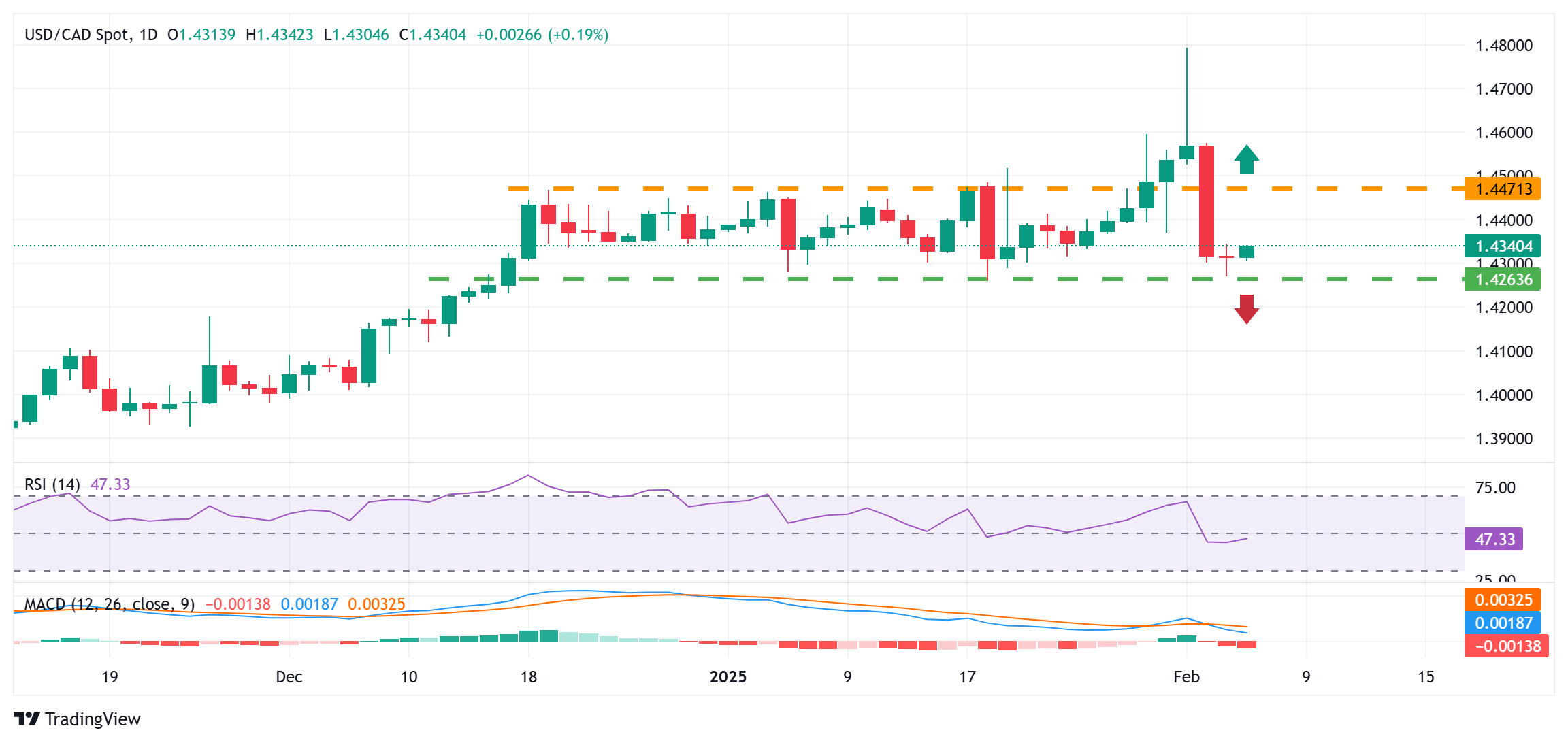USD/CAD Price Forecast: Climbs closer to mid-1.4300s; lacks bullish conviction
- USD/CAD attracts some buyers on Thursday amid a modest USD uptick.
- Spot prices, however, lack traction, warranting caution for bullish traders.
- Bears need to wait for a break below 1.4260 before placing fresh bets.
The USD/CAD pair ticks higher during the Asian session on Thursday and moves away from over a two-week low, around the 1.4270 region touched the previous day. Spot prices currently trade around the 1.4345 area, up over 0.20% for the day, though the uptick lacks bullish conviction.
The US Dollar (USD) attracts some buyers and for now, seems to have snapped a three-day losing streak to its lowest level in over a week. Furthermore, the recent fall in Crude Oil prices is seen undermining the commodity-linked Loonie against the backdrop of the Bank of Canada's (BoC) dovish outlook and acting as a tailwind for the USD/CAD pair. However, the USD bulls seem reluctant amid prospects for further policy easing by the Federal Reserve (Fed), which, in turn, caps the upside for the currency pair.
From a technical perspective, the USD/CAD pair found some support ahead of the year-to-date (YTD) low, around the 1.4260 area touched in January, and the subsequent move up warrants caution for bearish traders. That said, oscillators on the daily chart have just started gaining negative traction and suggest that the path of least resistance for spot prices is to the downside. Some follow-through selling below the 1.4270-1.4260 area will reaffirm the outlook and pave the way for a slide toward the 1.4200 round figure.
A convincing break below the latter will set the stage for an extension of this week's sharp retracement slide from the vicinity of the 1.4800 mark, or the highest level since April 2003. The USD/CAD pair might then weaken further below the 1.4170 support and accelerate the decline further towards the 1.4125 region en route to the 1.4100 round-figure mark.
On the flip side, any further move up beyond the 1.4355-1.4360 area is likely to face resistance ahead of the 1.4400 mark. The said handle could act as a pivotal point for intraday traders, which if cleared could lift the USD/CAD pair further towards the 1.4450 horizontal barrier en route to the 1.4500 psychological mark. Some follow-through buying beyond the 1.4535 hurdle will shift the bias back in favor of bulls and allow spot prices to reclaim the 1.4600 round figure and climb further towards the 1.4665-1.4670 region.
USD/CAD daily chart

Canadian Dollar FAQs
The key factors driving the Canadian Dollar (CAD) are the level of interest rates set by the Bank of Canada (BoC), the price of Oil, Canada’s largest export, the health of its economy, inflation and the Trade Balance, which is the difference between the value of Canada’s exports versus its imports. Other factors include market sentiment – whether investors are taking on more risky assets (risk-on) or seeking safe-havens (risk-off) – with risk-on being CAD-positive. As its largest trading partner, the health of the US economy is also a key factor influencing the Canadian Dollar.
The Bank of Canada (BoC) has a significant influence on the Canadian Dollar by setting the level of interest rates that banks can lend to one another. This influences the level of interest rates for everyone. The main goal of the BoC is to maintain inflation at 1-3% by adjusting interest rates up or down. Relatively higher interest rates tend to be positive for the CAD. The Bank of Canada can also use quantitative easing and tightening to influence credit conditions, with the former CAD-negative and the latter CAD-positive.
The price of Oil is a key factor impacting the value of the Canadian Dollar. Petroleum is Canada’s biggest export, so Oil price tends to have an immediate impact on the CAD value. Generally, if Oil price rises CAD also goes up, as aggregate demand for the currency increases. The opposite is the case if the price of Oil falls. Higher Oil prices also tend to result in a greater likelihood of a positive Trade Balance, which is also supportive of the CAD.
While inflation had always traditionally been thought of as a negative factor for a currency since it lowers the value of money, the opposite has actually been the case in modern times with the relaxation of cross-border capital controls. Higher inflation tends to lead central banks to put up interest rates which attracts more capital inflows from global investors seeking a lucrative place to keep their money. This increases demand for the local currency, which in Canada’s case is the Canadian Dollar.
Macroeconomic data releases gauge the health of the economy and can have an impact on the Canadian Dollar. Indicators such as GDP, Manufacturing and Services PMIs, employment, and consumer sentiment surveys can all influence the direction of the CAD. A strong economy is good for the Canadian Dollar. Not only does it attract more foreign investment but it may encourage the Bank of Canada to put up interest rates, leading to a stronger currency. If economic data is weak, however, the CAD is likely to fall.

